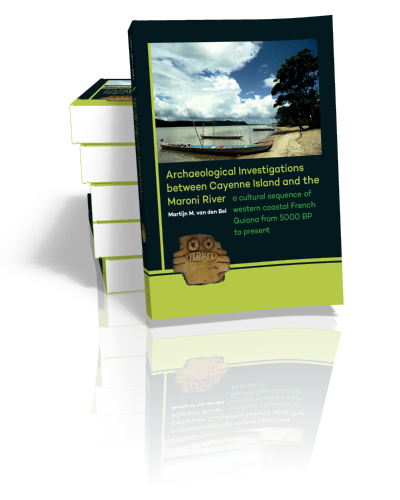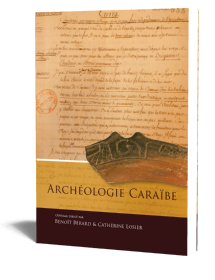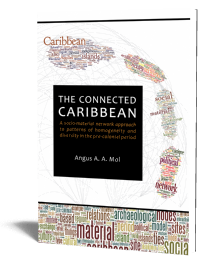Archaeological Investigations between Cayenne Island and the Maroni River
A cultural sequence of western coastal French Guiana from 5000 BP to present
Martijn van den Bel | 2015

Archaeological Investigations between Cayenne Island and the Maroni River
A cultural sequence of western coastal French Guiana from 5000 BP to present
Martijn van den Bel | 2015
Paperback ISBN: 9789088903304 | Imprint: Sidestone Press Dissertations | Format: 210x280mm | 752 pp. | Language: English | 139 illus. (bw) | 100 illus. (fc) | Keywords: archaeology, americas, pre-Columbian, South America, French Guiana | download cover
Read online or downloaded 323 times
-
Digital & Online access
This is a full Open Access publication, click below to buy in print, browse, or download for free.
-
Buy via Sidestone (EU & UK)
-
Buy via our Distributors (WORLD)
For non-EU or UK destinations you can buy our books via our international distributors. Although prices may vary this will ensure speedy delivery and reduction in shipping costs or import tax. But you can also order with us directly via the module above.
UK international distributor
USA international distributor
-
Bookinfo
Paperback ISBN: 9789088903304 | Imprint: Sidestone Press Dissertations | Format: 210x280mm | 752 pp. | Language: English | 139 illus. (bw) | 100 illus. (fc) | Keywords: archaeology, americas, pre-Columbian, South America, French Guiana | download cover
Read online or downloaded 323 times

We will plant a tree for each order containing a paperback or hardback book via OneTreePlanted.org.
Stratigraphic archaeological research in French Guiana is barely 50 years old and has been conducted primarily in the coastal zone, stretching approximately between 5 and 50 kilometres from the Atlantic coast to the Precambrian Shield. This bias, mainly caused by means of modern infrastructure, has sketched an archaeological record concerning pre-Columbian French Guiana focussing on the Late Ceramic Age (AD 900-1500) of Cayenne Island as well as the western Holocene coastal plains. The present study contains the results of six archaeological investigations, conducted from a compliance archaeological perspective, in order to enhance our knowledge of the afore-mentioned coastal area. It not only presents us with fresh archaeological data on the (Late) Archaic and Early Ceramic Age, a hiatus that is now partially filled up, but also sheds new light on the Late Ceramic Age of this specific region concerning funerary rites, ceramic series and subsistence economy.
Martijn van den Bel studied History and Archaeology of Indigenous America at Leiden University and graduated in 1995 with an ethnoarchaeological study on the Palikur potters of French Guiana. Currently he works as a project leader for Inrap in French Guiana. He carries out compliance archaeological research in the French Guiana and the French Lesser Antilles. Next to archaeology, Martijn is interested in the early history of the Guianas and the Lesser Antilles, notably the encounter between Amerindians and Europeans during the 16th and 17th century, resulting in various publications.
Preface
1. The present study and its objectives
1.1 Introduction
1.2 The research objectives
1.3 Compliance archaeology in French Guiana
1.4 The chronological stages and cultural taxonomy
1.5 A brief outline of this study
2. The landscapes of the eastern Guianas
2.1 The geographical setting
2.2 The geological setting
2.3 The coastal vegetation
2.4 The archaeological landscapes
3. A short history of archaeology in the Guianas
3.1 Introduction
3.2 Between the Orinoco and Amazon Rivers
3.3 French Guiana and Suriname
3.4 The Prehistoric Ages
3.5 Final remarks
4. The Archaic Eva 2 site
4.1 Introduction
4.2 The excavation methods and techniques
4.3 The geological context
4.4 The radiocarbon datings
4.5 The spatial organization
4.6 The lithic study
4.7 The starch grain analysis
4.8 The ceramic study
4.9 The site synthesis
5. The Chemin Saint-Louis site
5.1 Introduction
5.2 The geological context
5.3 The radiocarbon datings
5.4 The features
5.5 The ceramic analysis
5.6 The lithic study
5.7 The starch grain analysis
5.8 The site synthesis
6. The Crique Sparouine site
6.1 Introduction
6.2 The features
6.3. The lithic study
6.4. The ceramic study
6.5 The site synthesis
7. The AM 41 site
7.1. Introduction
7.2. The spatial distribution and diversity of the features
7.3. The ceramic study
7.4 The Iracoubo necropole
8. The PK 11 or Rorota site
8.1 Introduction
8.2 The stratigraphy
8.3 The radiocarbon datings
8.4 The features
8.5 The ceramic study
8.6 The lithic study
8.7 The starch grain analysis
8.8 The site synthesis
9. The Cimetière paysager Poncel site
9.1 Introduction
9.2 The geological setting
9.3 The radiocarbon datings
9.4 The features
9.5 The ceramic study
9.6 The lithic study
9.7 The starch grain analysis
9.8 The site synthesis
10. The Colonial Event
10.1 Introduction
10.2 The Contact Period (1500-1652)
10.3 The Colonial Period (1652-c.1950)
10.4 The present era
10.5 The Historic and present-day Amerindian material culture
11. The Historic Eva 2 site
11.1 Introduction
11.2 The features
11.3 The burials
11.4 The imported artefacts
11.5 The lithic material
11.6 The Amerindian ceramics
11.7 A brief history of Malmanoury
11.8. The site synthesis
12. The synthesis and reflections
12.1 The Archaic Age
12.2 The Ceramic Age
12.4 The chiefdoms
12.5 The Historic Age
12.6 Research questions answered
12.7 Conclusions
Epilogue
The Appendices
Bibliography
Annexes (on-line)
About the author
Dr. Martijn van den Bel
Martijn van den Bel has been living and working over a decade as an archaeologist for Inrap in Cayenne (French Guiana) and directs public excavations in the latter French Department as well as the French Antilles. At the moment he is finishing his PhD at the University of Leiden directed by Corinne Hofman and Arie Boomert, discussing the prehistory of the coastal area of French Guiana between the Cayenne and the Maroni Rivers.
Abstract:
Stratigraphic archaeological research in French Guiana is barely 50 years old and has been conducted primarily in the coastal zone, stretching approximately between 5 and 50 kilometres from the Atlantic coast to the Precambrian Shield. This bias, mainly caused by means of modern infrastructure, has sketched an archaeological record concerning pre-Columbian French Guiana focussing on the Late Ceramic Age (AD 900-1500) of Cayenne Island as well as the western Holocene coastal plains. The present study contains the results of six archaeological investigations, conducted from a compliance archaeological perspective, in order to enhance our knowledge of the afore-mentioned coastal area. It not only presents us with fresh archaeological data on the (Late) Archaic and Early Ceramic Age, a hiatus that is now partially filled up, but also sheds new light on the Late Ceramic Age of this specific region concerning funerary rites, ceramic series and subsistence economy.
Martijn van den Bel studied History and Archaeology of Indigenous America at Leiden University and graduated in 1995 with an ethnoarchaeological study on the Palikur potters of French Guiana. Currently he works as a project leader for Inrap in French Guiana. He carries out compliance archaeological research in the French Guiana and the French Lesser Antilles. Next to archaeology, Martijn is interested in the early history of the Guianas and the Lesser Antilles, notably the encounter between Amerindians and Europeans during the 16th and 17th century, resulting in various publications.
Contents
Preface
1. The present study and its objectives
1.1 Introduction
1.2 The research objectives
1.3 Compliance archaeology in French Guiana
1.4 The chronological stages and cultural taxonomy
1.5 A brief outline of this study
2. The landscapes of the eastern Guianas
2.1 The geographical setting
2.2 The geological setting
2.3 The coastal vegetation
2.4 The archaeological landscapes
3. A short history of archaeology in the Guianas
3.1 Introduction
3.2 Between the Orinoco and Amazon Rivers
3.3 French Guiana and Suriname
3.4 The Prehistoric Ages
3.5 Final remarks
4. The Archaic Eva 2 site
4.1 Introduction
4.2 The excavation methods and techniques
4.3 The geological context
4.4 The radiocarbon datings
4.5 The spatial organization
4.6 The lithic study
4.7 The starch grain analysis
4.8 The ceramic study
4.9 The site synthesis
5. The Chemin Saint-Louis site
5.1 Introduction
5.2 The geological context
5.3 The radiocarbon datings
5.4 The features
5.5 The ceramic analysis
5.6 The lithic study
5.7 The starch grain analysis
5.8 The site synthesis
6. The Crique Sparouine site
6.1 Introduction
6.2 The features
6.3. The lithic study
6.4. The ceramic study
6.5 The site synthesis
7. The AM 41 site
7.1. Introduction
7.2. The spatial distribution and diversity of the features
7.3. The ceramic study
7.4 The Iracoubo necropole
8. The PK 11 or Rorota site
8.1 Introduction
8.2 The stratigraphy
8.3 The radiocarbon datings
8.4 The features
8.5 The ceramic study
8.6 The lithic study
8.7 The starch grain analysis
8.8 The site synthesis
9. The Cimetière paysager Poncel site
9.1 Introduction
9.2 The geological setting
9.3 The radiocarbon datings
9.4 The features
9.5 The ceramic study
9.6 The lithic study
9.7 The starch grain analysis
9.8 The site synthesis
10. The Colonial Event
10.1 Introduction
10.2 The Contact Period (1500-1652)
10.3 The Colonial Period (1652-c.1950)
10.4 The present era
10.5 The Historic and present-day Amerindian material culture
11. The Historic Eva 2 site
11.1 Introduction
11.2 The features
11.3 The burials
11.4 The imported artefacts
11.5 The lithic material
11.6 The Amerindian ceramics
11.7 A brief history of Malmanoury
11.8. The site synthesis
12. The synthesis and reflections
12.1 The Archaic Age
12.2 The Ceramic Age
12.4 The chiefdoms
12.5 The Historic Age
12.6 Research questions answered
12.7 Conclusions
Epilogue
The Appendices
Bibliography
Annexes (on-line)
About the author
Dr. Martijn van den Bel
Martijn van den Bel has been living and working over a decade as an archaeologist for Inrap in Cayenne (French Guiana) and directs public excavations in the latter French Department as well as the French Antilles. At the moment he is finishing his PhD at the University of Leiden directed by Corinne Hofman and Arie Boomert, discussing the prehistory of the coastal area of French Guiana between the Cayenne and the Maroni Rivers.
-
Digital & Online access
This is a full Open Access publication, click below to buy in print, browse, or download for free.
-
Buy via Sidestone (EU & UK)
-
Buy via our Distributors (WORLD)
For non-EU or UK destinations you can buy our books via our international distributors. Although prices may vary this will ensure speedy delivery and reduction in shipping costs or import tax. But you can also order with us directly via the module above.
UK international distributor
USA international distributor
- Browse all books by subject
-
Search all books

We will plant a tree for each order containing a paperback or hardback book via OneTreePlanted.org.
You might also like:
© 2025 Sidestone Press KvK nr. 28114891 Privacy policy Sidestone Newsletter Terms and Conditions (Dutch)








